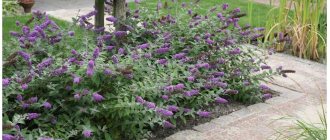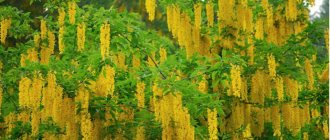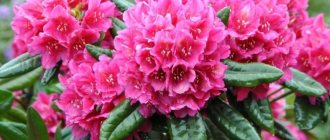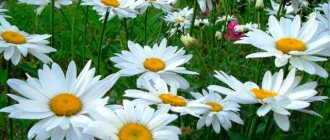Garden daisies are especially popular among Russian flower growers and landscape designers. Their popularity is explained by their visual appeal, unpretentiousness and medicinal properties. Anyone can grow a flower in their own garden plot or flower garden near their home; it is enough to know the basic rules for caring for the crop.
A distinctive feature of perennial garden chamomile is its huge buds.
Features of the flower
There are a large number of varieties of garden chamomile. Each representative of a culture has its own characteristics and external differences. But there is also a unifying feature, which is expressed by an inflorescence in the form of a basket with a yellow core and snow-white petals. The exception is colored hybrids.
Garden crops differ from their wild counterparts in the following ways:
- large buds;
- abundant and long flowering;
- the possibility of re-ovarying inflorescences.
The perennial plant belongs to the Astrov family; it stands out from its fellows with a thin stem that can reach 60 cm in height.
Bipinnate leaf plates are arranged alternately on the shoot. And at the very top there are large flowers, the size of which varies between 10-15 cm.
The distinctive features of garden chamomile are its rapid development and growth, early bud formation and long flowering, which lasts from mid-June to the end of summer.
Breeders managed to develop chamomile with semi- and double flowers, in which the petals are arranged in several rows, they look like balls
External signs
The main characteristic of daisies is the appearance of the flower, which consists of white petals and a yellow center. The daisy genus includes many different crops. Moreover, they are low herbaceous plants with pinnately dissected leaves. Each of them includes many thin lobes.
The diameter of the conical or hemispherical baskets can be different - from 2 to 20 cm. The structure includes 2 types of petals - tubular yellow in the center and pistillate white at the edges.
Regular garden daisies have white petals and a yellow center.
Varieties and characteristics
Chamomile has been cultivated for over 500 years. During this period of time, many new varietal representatives have appeared, but not all are popular among gardeners.
There are species that are found everywhere:
- Nivyanik is a classic perennial garden chamomile; planting and caring for it in the open ground is not difficult. The flower grows up to 70 cm, and the buds reach a diameter of 7 cm. Nivyanyak blooms for almost two months, and the first flowers appear at the beginning of the first summer month.
- Northern Star is one of the leading perennial varieties among flower growers. The plant has a high level of frost resistance and loves sun and moist soil. The variety is easy to propagate; the seeds germinate within the third week after sowing.
- Princess - low, lush bushes are suitable for planting in open ground, so they can often be found in park areas and borders. Good frost resistance allows you to decorate garden areas with flowers. The diameter of the buds is approximately 8 cm, the bushes are literally strewn with flowers.
- Pyrethrum - most representatives of this chamomile are small-flowered, the buds do not exceed 6 cm. Although there are giant specimens that grow up to 80 cm in length, and the diameter of the flowers exceeds 12 cm. These are winter-hardy and shade-tolerant varieties with long and abundant flowering.
Colored daisies are very beautiful flowers, attracting with their unusual appearance and color of the petals. They are not traditionally white, but pink, burgundy, yellow and crimson. These perennial hybrids continue to bloom throughout the season.
The most popular colored representatives are “Erigeron”, “Paradise”, “Golden Ball”.
Each variety has its own characteristics in cultivation and requirements regarding conditions. When to plant perennial chamomile depends on the age of the plant, but usually this is done every three years; it is not worth keeping the plant in one place for more than five years.
The “Princess” variety is compact in size, the height of an adult bush does not exceed 30 cm, these flowers can be grown in a flower pot
Types of daisies - flowering border perennials
Today, the classification of daisies includes more than 25 varieties of this cute flower: from the pharmacy chamomile, known to everyone, to the original blue daisy, the petals of which, as the name implies, can have unique shades - from sky blue to deep blue.
Perennial blue chamomile
Chamomile - perennial or annual
Depending on the variety, chamomile can be either annual or perennial. For example, the garden varieties Banana Cream and Snegurka are perennial varieties, while chamomile is an annual plant.
Description of colors
Chamomile (in Latin “Matricária” - “mother herb”) is a flower, amazing in its simplicity, belonging to the Asteraceae or Asteraceae family.
Chamomiles can be semi-double or double, their petals can differ from each other: there are flowers with thin and wide, curved and straight. Moreover, varieties have been bred that have no petals at all. Some varieties have a slight odor, while others have no odor at all.
For your information! Many gardeners wonder how many petals a chamomile has. There is no exact answer to this question, the whole point is that each flower is individual, and the number of petals, even within one variety, can range from 10 to 34 pieces.
Information about where daisies grow deserves special attention. Thanks to small seeds that the wind can blow over fairly long distances, all over the world you can see neat clearings or single bushes, pleasing the eye with their simplicity. Another important factor that allows daisies to feel equally good in Africa and the USA, as well as in Australia and Eurasia, is their unpretentiousness and ability to quickly adapt to a wide variety of climate conditions.
The classic field chamomile has white petals
Beginning gardeners often wonder when field daisies bloom. Flowering begins in the second half of April, continues throughout the warm period and ends in September with the onset of cold weather. Most of the flowers open in the summer, during June and July. However, in regions where the climate is mild and warm, for example, in the Caucasus, Crimea and the Mediterranean, daisies bloom quite early, you can admire them already at the end of February.
Note! Each bush produces more and more inflorescences throughout the summer months, making it seem as if the flowering is continuous.
The most popular representative of the family is field chamomile, which has a number of useful qualities. Thus, scientists specializing in the science of pharmacognosy were able to find out that the essential oil included in the inflorescences has antiseptic and disinfectant properties and has a beneficial effect on the mucous membranes. Speaking about the beneficial properties of chamomile, one cannot fail to mention vitamins and minerals that can strengthen and nourish hair, giving it shine and a healthy appearance.
Dried flowers for collection
Important! The components that make up the chamomile collection help get rid of colds, improve the functioning of the gastrointestinal tract, eliminate redness and flaking, and can cure itching.
It is not surprising that gardeners from different parts of the world plant low-maintenance plants on their plots. Listed below are the most attractive varieties of daisies that will decorate any, even the smallest garden plot.
Features of cultivation
There are no serious difficulties when growing perennial garden chamomile. She is unpretentious, so even a beginner can breed.
Sowing seeds
Sowing work is carried out taking into account the method of cultivation: there are seedlings and non-seedlings. The first option is considered more reliable.
For seedlings
Sowing of planting material for seedlings is carried out in the spring; March is considered the ideal month. Before planting daisies, prepare containers with drainage holes.
You will need nutritious soil made from peat and sand, the components are taken in equal quantities.
Then proceed like this:
- 3 seeds are placed in each hole; after planting, they are covered lightly with soil.
- The container must be covered with material; this is done to create conditions close to greenhouse conditions.
- It is strictly not recommended to keep a container with plantings on a sunny windowsill, since high intensity can damage fragile seedlings. It is also important to monitor the soil moisture level before replanting; it should not dry out.
When to replant perennial chamomile depends on the climatic conditions of the region, but this is usually done in May, during which time the soil has already warmed up.
The small bush chamomile looks very beautiful, the variety name is Pyrethrum
In open ground
Planting seeds in open flower beds occurs when the threat of frost has passed. It is best to carry out planting work in mid-May; in the south you can plant flowers a little earlier.
This is done as follows:
- shallow grooves are made in the selected area;
- holes are made at a distance of 25 cm, their depth should be approximately 15 mm;
- One seed is added to each;
- then cover the planting material with soil;
- watered with a growth stimulating agent.
Using the same scheme, you can transplant chamomile seedlings. In this case, the first buds can be expected next spring.
When sowing chamomile seeds in an open area, you need to make sure that there is no groundwater near the flowerbed. They have a bad effect on the plant.
What does chamomile mean in the “language of flowers”?
Chamomile symbolizes innocence, simplicity, lightness, spiritual purity and purity. This flower is more suitable for very young girls, as well as children. Chamomile has several sacred meanings:
- in Scandinavian mythology, chamomile was a symbol of the goddess Freya, who is responsible for love, motherhood and fertility;
- in Roman mythology, a beautiful legend about the god Vertumnus and the nymph Belides is associated with daisies - the nymph, in order not to offend the loving god, turned into a field of daisies, thus avoiding an unwanted marriage;
- from English the name of the flower is translated as “sunny window”, since the snow-white petals open from exposure to direct sun and close with the arrival of night;
- the Slavs considered chamomile a sacred plant because of its medicinal properties and effectiveness, therefore, in Slavic mythology, chamomile became the personification of strength, health, and strength;
- According to Feng Shui, the yellow center of the flower symbolizes vital energy, and the snow-white petals symbolize physical/spiritual healing, so bouquets of daisies should always be in the house, bringing joy and happiness to the owner.
Daisies are simple, unpretentious, inexpensive flowers. But how nice it is to receive them as a gift! Miniature “suns” will bring a lot of joy and happiness. Give daisies for the holidays and for no reason. This flower is worthy of attention!
Plant care rules
Caring for chamomile is not difficult; the plant is considered unpretentious, so anyone can grow it. The flowering crop is a light-loving plant; it will grow well in a nutritious, loose substrate, but it should not be transplanted to a place with groundwater.
Watering activities should not be frequent; soil should be moistened only after drying. It is important to choose the right time for the procedure: it is best to choose early morning or evening, when the sunlight is no longer so intense. Droplets of water on foliage and petals can act as a lens and cause burns.
Lush and long-lasting flowering of garden chamomile is ensured by timely feeding
A prerequisite for growing a flower is loosening and weeding the surface layer of soil. It is important to provide the crop with timely fertilization. This is done in the spring; nitrogen complexes will be the best feeding at this time.
Caring for chamomile after flowering involves the inclusion of several agrotechnical measures:
- removal of faded inflorescences, pruning is carried out directly from the stem;
- in late autumn, adult clumps are divided;
- During the same period, old dead parts of plants are pruned.
It is also important to deoxidize the soil in late autumn if necessary. To do this, add lime or dolomite flour to the flowerbed.
You should not keep border chamomile in one place for more than five years. At this age, she is already wasting her decorative appeal. The flower can be replaced with a new one or a rejuvenating procedure can be performed.
Collection recommendations
Harvesting chamomile is easy. The optimal period for harvesting raw materials is when the plant is flowering.
Experienced herbalists advise collecting chamomile on the 5th day after blooming. At this moment, the petals are in a horizontal position, and the middle is not fully open. It is at this time that chamomile contains the maximum amount of valuable components.
To obtain high-quality raw materials, it is important to collect them correctly.
Flowers should only be collected in dry and warm weather. The inflorescences must be carefully separated from the stems. This can be done manually or using a special tool. You should not pull out bushes with roots.
The culture blooms from early summer to late autumn. During the growing season, flowers can be collected 3 times. After flowering is completed, the plant loses its benefits. Therefore, it is pointless to use it for preparations.
It is not recommended to collect raw materials in contaminated areas. This should not be done along roadsides or near industrial enterprises.
Reproduction methods
There are several ways that daisies reproduce. The first option is to divide the bush, which has reached three years of age, into several separate parts. Then put each one in its own separate place.
The second method of propagating chamomile involves sowing seed directly into the soil at the dacha or in the garden. But it is better to plant seedlings in open areas. The chance that the plant will adapt to the new environment in this case is much higher.
It is best to replant and divide shrubs in September.
Mature shrubs quickly take root and adapt to the new environment. In addition, they are not afraid of the cold. Transplanting in the fall will ensure the buds set in the spring, which means you won’t have to wait a whole year for the long-awaited flowering.
You can collect planting material yourself.
Instructions on how to collect chamomile seeds:
- Even in the summer, you need to choose the variety you like, the bush must be healthy and strong;
- Next you need to let the bud bloom, it should dry completely;
- wait until the core changes color from yellow to deep brown;
- it is important to wrap the flower in gauze;
- then you should press in the middle, the seeds will easily disintegrate.
After collection, the seeds are dried and removed before sowing. Planting material has a high germination rate.
Chamomile seeds look like this
Possible side effects
If the recommended dosage is followed, adverse reactions to taking chamomile preparations rarely occur. Since chamomile oil has a more pronounced effect than a water infusion, its use is more likely to cause side effects. Not excluded:
- skin allergic reactions;
- diarrhea;
- nausea and vomiting.
When using chamomile preparations, you must follow the dosage indicated in the instructions, otherwise you can harm the body. An overdose can manifest itself as headache, weakness, and tachycardia.
If recommended doses are exceeded for a long time, depression of the central nervous system and decreased muscle tone are possible.
Pests and diseases
With proper care, flower growers do not encounter any difficulties, but if the rules are not followed, problems will arise regularly.
Bush daisies often suffer from the following diseases:
- Powdery mildew appears as a white coating on the stem and leaf blades. If you do not take action, the plaque soon begins to turn brown. Afterwards the plant dries out and dies. Treating parts of the flower with fungicidal preparations will help correct the situation.
- Gray rot, this problem can be identified by the brown spots that appear on the leaves and stems. At the beginning of the development of the disease, they are almost invisible, but spread quickly and can affect large areas.
- Rust on daisies, the primary sign of the disease is the presence of dark orange spots on the leaf on the front side. Fungal spores are usually found on the reverse side.
Special remedies will help get rid of fungal diseases. Fungicides called Fundazol and Kuproxat have proven themselves well.
Harmful insects are also not a rare guest on garden daisies. Most often, gardeners encounter wireworms, star-winged flies and aphids on plants. They get rid of them with the same fungicides.
Rust is easily identified by pads with fungal spores on the back of the leaf blade of daisies
origin of name
In the ancient world, the chamomile plant was known as chamaemelon, which translated from ancient Greek means “earth apple.” Chamomile was so named due to the aroma of its flowers, reminiscent of the smell of apples. In medieval Europe, the plant was called chamaemelon romana, the second word indicating the ancient Roman origin of the name.
In Russian, romana was transformed into “novel”, “romannik”, “romanov color”. By the end of the 18th century, the diminutive form of these names, “chamomile,” became widespread.
The scientific name Matricaria chamomilla was assigned to the plant in the 18th century. A doctor and botanist from Switzerland, Albrecht von Haller, decided to name one of the genera of the Asteraceae family - Matricaria, taking as a basis the Latin name for the uterus - matrix.
This word was not chosen by chance, because a close relative of chamomile, non-odorous chamomile, has long been used to treat gynecological diseases. Subsequently, three-rib was isolated into a separate genus, and the name that appeared, thanks to it, went to the genus of the Astrov family, to which chamomile belongs.
The specific name chamomilla was introduced into the botanical classification by the Swedish botanist Carl Linnaeus, taking the Latin name chamaemelon as a basis.
Using flowers in landscape design
Garden chamomile is often found in landscape design. Most often, the perennial is used as a decoration for slides and borders. Luxurious bouquets are formed from high varieties.
The flowering crop looks very beautiful against the backdrop of garden lilies, cornflowers, and bells.
Red poppy and calendula will be good neighbors for the plant. Low bushes can become a wonderful decoration for green flower beds or paths.
And although daisies are not recognized by many (they are considered too simple and modest), today they are increasingly found in the most exquisite country compositions. If large or colored daisies are used wisely, they will become the main decoration of the flowerbed.
Chemical composition
Let's analyze the most common species of Matricaria - chamomile. Its main components:
- vitamins (B1, B2, E, C and PP);
- saturated fatty acids;
- macroelements (potassium, calcium, phosphorus, sodium, magnesium);
- trace elements (iron);
- digestible carbohydrates (mono- and disaccharides);
- tannins and proteins;
- essential oil.
Chamomile is unique because it contains rare substances of plant origin. The glycoside increases appetite and bile secretion. Chamazulene in the plant enhances the effect of the essential oil and increases the heart rate.
Chamomile is unique in its chemical composition
Hair infusion
In order to strengthen hair, the following remedy is prepared. A few spoons of dry chamomile are poured into a liter of boiled water. The composition is infused for half an hour. The liquid is then filtered and used to wash your hair.
Chamomile decoction allows you to give light hair a golden hue. To prepare such a product, you need to take about 200 grams of raw materials and brew them in 0.5 liters of boiling water. The composition should be simmered over low heat for 5 minutes. Then the product is allowed to brew. The composition is applied to the hair immediately after washing.
How to store it correctly?
Its benefits depend on the correct drying of the plant. If you are collecting only flowers without stems, they should be spread evenly in one layer on a clean surface. It is important to avoid direct sunlight on the raw materials. It is imperative to ensure adequate air circulation.
If the flower was collected with a stem, the plants can be tied into bunches and hung in a dry and dark room. In this case, you also need to ensure good ventilation.
To dry the flowers evenly, they need to be constantly turned over. Drying time is usually a maximum of 2 weeks. From 1 kg of fresh plants it is possible to obtain approximately 250 g of dry raw materials.
The finished product should be completely dry and rustling.
Experts do not recommend drying crops in electric dryers and cabinets. Heat treatment leads to the loss of most of the nutrients.
Flowers can be kept in glass jars.
At the final stage, you need to prepare the chamomile for storage. In this case, it is permissible to use the following options:
- Cardboard boxes. This is the simplest option. It is recommended to store raw materials in a dark and well-ventilated place. It is important to ensure that the room is cool enough.
- Textile bags. In such a situation, it is recommended to use bags made of natural fabrics. They must be unpainted. Dried raw materials should be placed in containers and hung on the walls. This will help maintain its shape and benefits.
- Glass jars. In them, dried raw materials look very decorative. If the containers are beautifully decorated, they can be used as part of the interior.











